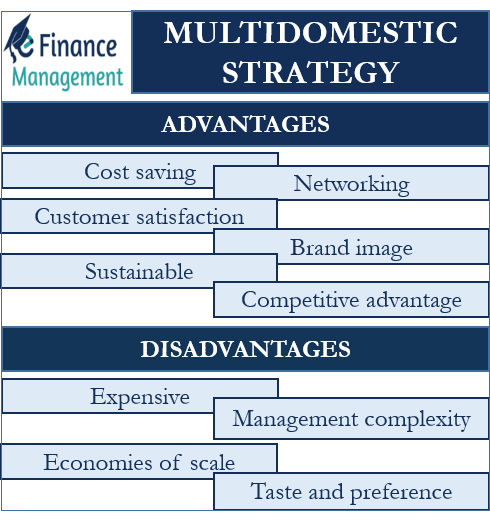After a business achieves success in the local market, it may plan to expand globally. Though many strategies help businesses expand overseas, one of the most popular ones is the Multidomestic strategy. A business using this strategy customizes its sales, marketing, and product development to suit the taste and preferences of the market they want to expand in. Though this strategy has helped many well-known brands to expand overseas successfully, it also suffers from a few drawbacks. Thus, it is very important for a business pursuing (or planning to pursue) this strategy to be aware of the advantages and disadvantages of multidomestic strategy.
Advantages of Multidomestic Strategy
The following are the advantages of multidomestic strategy:
Cost Saving
Businesses can save costs by using this strategy. Under this strategy, a business must develop products to meet local tastes and preferences. Thus, they are inclined to source products or raw materials locally, which are usually cheaper. It also allows companies to avoid importing products or raw materials. All this eventually results in cost savings.
Networking
Better marketing connection is another advantage of this strategy. We all know that people of different cultures and ethnicity have different perspectives. To capture this, a company needs to alter its marketing strategy. Doing this boosts the chances of a company connecting with the local market, as well as gaining consumer loyalty.
Customer Satisfaction
The use of this strategy also helps in improving customer satisfaction. Since the strategy involves conducting in-depth market research, a business can use this data to offer a better buying experience. Or, we can say it allows businesses to address the customers’ needs directly. This eventually helps if offering better satisfaction to the end user.
Also Read: Multidomestic Strategy Examples
Brand Image
It helps businesses build a better brand image as well. Businesses using this strategy spend a good amount of time and resources to understand the specifics of a market. It allows businesses to develop relevant products to enrich the overall user experience. Moreover, offering products that don’t contradict, but rather respect, local culture and traditions always go well with the customers. This eventually helps in building, as well as sustaining, a positive brand image.
Sustainable
The use of this strategy also means greater sustainability for the parent firm. Since a company (practicing a multidomestic strategy) uses different strategies for each market, a failure at one location doesn’t mean the failure of the whole organization. Or, we can say that the failure of a multidomestic in one market doesn’t mean the strategy would fail in other markets as well. This way, the multidomestic strategy offers greater sustainability to the organization.
Competitive Advantage
Businesses can gain a competitive advantage using this strategy as well. Since businesses gain crucial data on the local market, including local culture, taste, preferences, and competitor strategies, it allows them to develop a competitive advantage.

Disadvantages of Multidomestic Strategy
The following are the disadvantages of multidomestic strategy:
Expensive
Multidomestic strategy is very expensive to adopt and implement. Conducting research on new markets, carrying out marketing campaigns, and developing strategies could prove extremely expensive. For instance, a business needs to hire and train local staff or develop a whole new product to win the local market. All this requires a lot of investment.
Economies of Scale
The use of a multidomestic strategy could also block economies of scale. Usually, when a company expands globally, it means producing large quantities of products. And this results in economies of scale. However, a company using a multidomestic approach may need to produce different products for different markets. As a result, it may not be able to gain economies of scale.
Management Complexity
Managing a business pursuing multidomestic strategy is also challenging. A multi-domestic approach means creating semi-autonomous subsidiaries that use different strategies. This could complex the organizations structure, making it difficult to manage the whole thing.
Taste and Preference
The success of this strategy depends largely on the ability of the company to match the taste and preferences of the local audience.
Final Words
Despite the drawbacks, multidomestic strategy has helped many businesses to make a global impact. However, it is important for businesses to work on these drawbacks to achieve maximum success with this strategy. Also, businesses must understand that though a multidomestic strategy assists in creating a robust connection with end users, businesses need to forgo short-term gains that they can get by offering standardized products. Or, we can say businesses must wait a few years instead of months to get desired results from a multidomestic strategy.
RELATED POSTS
- Advantages and Disadvantages of International Business
- Advantages and Disadvantages of Cost Leadership Strategy
- International Market – Lucrative But Challenging As Well
- Advantages and Disadvantages of Focus Strategy
- Advantages and Disadvantages of Differentiation Strategy
- Concentric Diversification – Meaning, Advantages, and More

